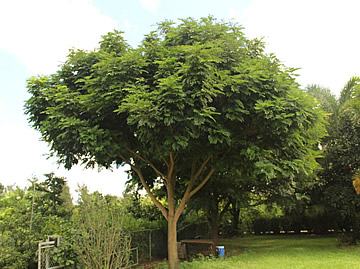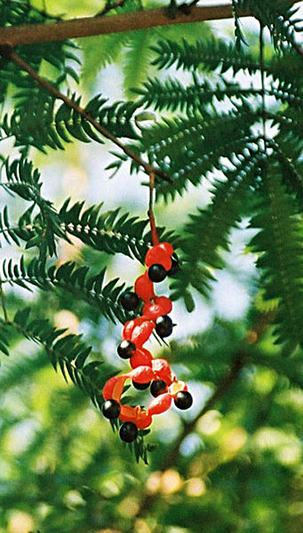The Wild Tamarind (Cojoba arborea) is a tree from the legume family, with a majestic stature, providing ample shade and distinctive pendulous fruits that are highly ornamental. Native to Central America, the Caribbean, Mexico, Bolivia, and Ecuador, it is not typically found in dense forests but is generally located in open areas or transitional zones.
Its canopy is broad and open, with a single or branched trunk, often twisted, measuring about 20 inches (approximately 50 centimeters) in diameter and usually reaching heights of 20 to 30 feet (about 6 to 9 meters), but it can exceptionally reach up to 115 feet (approximately 35 meters). The leaves are alternate, compound bipinnate, and smooth, with elliptical leaflets. They initially appear in reddish tones and mature to a medium, shiny green color.
Inflorescences emerge in the spring and are of the capitulum type, spherical, hermaphroditic, with long white stamens, resembling small pompons. The fruits that follow are curved and dehiscent pods, vivid red in color, about 6 inches (approximately 15 cm) in length, containing 4 to 8 black, ellipsoid seeds.

The Wild Tamarind is a tree to be appreciated in large spaces such as parks, public squares, and extensive residential gardens. It provides refreshing shade during the summer due to its wide and leafy canopy. In this species, the fruits, in contrast to the seeds, are the main attraction.
Therefore, it is interesting to plant it in areas where it can be easily seen by observers. Its wood has a medium texture, is hard, heavy, strong, and durable, but it is not difficult to work with. It is used in construction, as well as for stakes, poles, furniture, paper, stairs, floors, and general carpentry.
It should be cultivated in full sun, in fertile, deep soil enriched with organic matter, and regularly irrigated. It thrives in a tropical, warm, and humid climate, growing at altitudes of up to 6,500 feet (approximately 2,000 meters). It does not tolerate frost.
Propagation of the Wild Tamarind is done by seeds, which should be collected fresh from ripe fruits and immediately placed in fertile substrate, kept moist. Germination occurs in about 22 days. Seedlings are ready for planting in their final location in 5 to 8 months. Transplant during the rainy season.


